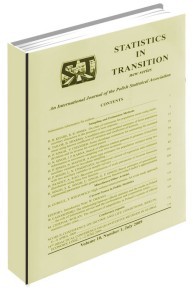An evaluation of design-based properties of different composite estimators
An evaluation of design-based properties of different composite estimators
Author(s): Daniel Bonnéry, Yang Cheng, Partha LahiriSubject(s): Business Economy / Management
Published by: Główny Urząd Statystyczny
Keywords: calibration; estimated controls; longitudinal survey; labor force statistics
Summary/Abstract: For the last several decades, the US Census Bureau has been applying AK composite estimation method for estimating monthly levels and month-to-month changes in unemployment using data from the Current Population Survey (CPS), which uses a rotating panel design. For each rotation group, survey-weighted totals, known as monthin-sample estimates, are derived each month to estimate population totals. Denoting the vector of month-in-sample estimates by Y and the design-based variance-covariance matrix of Y by Σ, one can obtain a class of AK estimators as linear combinations of Y, where the coefficients of a linear combination in the class are functions of the two coefficients A and K. The coefficients A and K were optimized by the Census Bureau under rather strong assumptions on Σ such as the stationarity of Σ over a decade. We devise an evaluation study in order to compare the AK estimator with a number of rival estimators. To this end, we construct three different synthetic populations that resemble the Current Population Survey (CPS) data. To draw samples from these synthetic populations, we consider a simplified sample design that mimics the CPS sample design with the same rotation pattern. Since the number of possible samples that can be drawn from each synthetic population is not large, we compute the exact Σ and the exact mean squared error of all estimators considered to facilitate comparison. To generate the first set of rival estimators, we consider certain subclasses of the broader class of linear combinations of month-in-sample estimates. For each subclass, when Σ is known, the optimum estimator is obtained as a function of Σ. An estimated optimal estimator in each subclass is then obtained from the corresponding optimal estimator when Σ is replaced by an estimator. Neither the AK estimator nor the estimated optimal estimators for these subclasses performed well in our evaluation study. In our real life data analysis, the AK estimates are constantly below the survey-weighted estimates, indicating potential bias. Our study indicates limitations of the approach that generate an estimated optimal estimator by first obtaining the optimal estimator in a class of linear combination of Y and then substituting in the optimal estimator an estimate of Σ. Any attempt to improve on the estimated optimal estimator in any given class would require a thorough investigation of the highly non-trivial problem of estimation of Σ for a complex setting like the CPS. We have not discussed this problem in this paper. Instead, we adapted the regression composite estimator used by Statistics Canada in the CPS setting. Unlike the estimated optimal estimators, the regression composite estimator does not require estimation of Σ and is less sensitive to the rotation group bias in our simulation study. Our study indicates that there is a great potential for regression composite estimation technique in improving estimation of both levels and month-to-month changes in the unemployment rates.
Journal: Statistics in Transition. New Series
- Issue Year: 21/2020
- Issue No: 4
- Page Range: 166-190
- Page Count: 25
- Language: English

